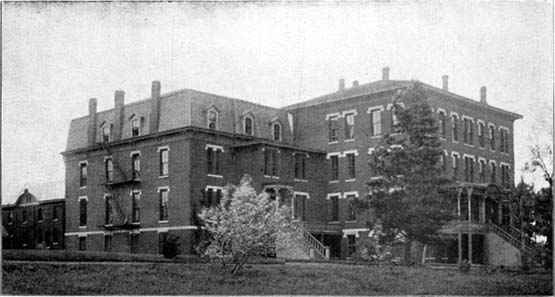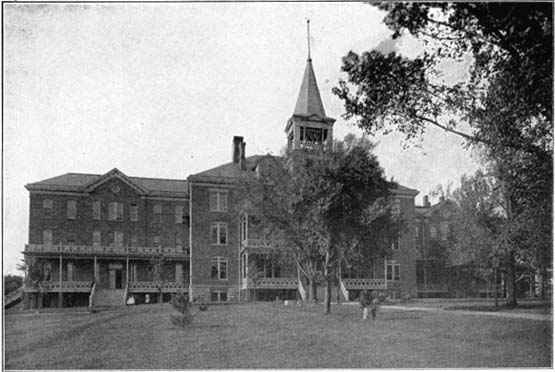|
STATE INSTITUTIONS. CHAPTER Xl This institution is located at Omaha, and its grounds comprise twenty-three acres. At first there was but one brick building, while now the buildings number seven brick and three frame. The buildings and furnishings are valued at $300,000.00. The school was established in 1869, with an attendance of only thirteen pupils, and during the first year, the institution was maintained at a cost of $2,995. At present there is an attendance of about two hundred afflicted boys and girls and every year about $40,000.00 are expended in the support of the school. Since its establishment, the school has had five superintendents, William M. Finch having been the first one to hold that position. Two years later, R. H. Kinney, from Columbus, Ohio, was put in charge and he remained in this position during eight years. He was followed by J. A. Gillespie and wife, who came from the Iowa Institution at Council Bluffs. At this time there were fifty-three students, but at the end of their twenty years' administration the number had increased to one hundred and sixty. In 1897, H. E. Dawes succeeded Mr. Gillespie and in 1901, R. E. Stewart, the present superintendent, began his term of office. Besides the usual courses of instruction, an industrial department is connected with the school, in which students are taught to be self-supporting. Four graduates of the 1903 class of this institution are now enrolled in Gallandet College, the national college for the deaf at Washington, D. C. The school term is nine months long. The students are furnished everything free with the exception of clothing and railroad fare. In 1899 an appropriation of $38,700 was granted by the legislature for new school buildings. Only well trained teachers are employed, by whom the pupils are attended with special care. Sickness is prevented by regular diet, exercise and cleanliness. The students become good self supporting citizens and many of them attain remarkable success. |
Institute for the Deaf and Dumb, Omaha |
Institute lot the Blind, Nebraska City. The Nebraska School for the Blind. This school is a state institution at which attendance is absolutely free. The pupils receive instruction and are given board and rooms at the institute without cost, the only requirement being that they shall furnish their own clothing. The school was established at Nebraska City in 1875 and Professor Samuel Bacon, a blind man, acted as its first superintendent. There are three departments of instruction, the literary, the music and the industrial. In the literary department the common and high school branches are taught; in the music department, courses in vocal and instrumental music are given; in the industrial department, means of making a livelihood are taught, such as piano tuning, broom making, weaving, sewing and cooking. The attendance numbers fifty-five pupils, and the compensation of officers is as follows: Superintendent and Steward, $1,800 per annum; Matron, $400.00 per annum; Physician, $180.00 per annum. The superintendents who have had charge of the school since its establishment and the dates of beginning their term are as follows: Samuel Bacon, March 1, 1875; J. B. Parmalee, November 22, 1877; C. D. Rakestraw, April 21, 1891; J. B. Parmalee, May 5, 1891; C. D. Rakestraw, February 15, 1892; Wm. Ebright, April 10, 1893; D. Neil Johnson, Ocotber (sic) 5, 1895; Wm. A. Jones, March 1, 1896; J. E. Harris, June 9, 1899; J. T. Morey, March, 1901. The total appropriation necessary to sustain the school is between $50,000.00 and $60,000.00 biennially |
 |
 |
 |
 |
|
@ 2002 for the NEGenWeb Project by Pam Rietsch, Ted & Carole Miller |
|||

